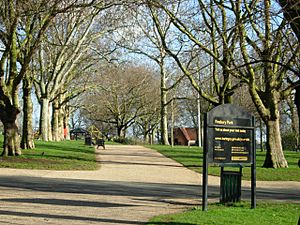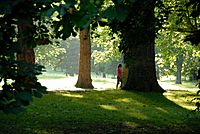Finsbury Park facts for kids
Quick facts for kids Finsbury Park |
|
|---|---|
 |
|
| Location | Harringay, London |
| Area | 46 hectares (110 acres) |
| Designer | Frederick Manable |
| Operated by | London Borough of Haringey |
| Open | 24 hours |
| Awards | Green Flag Award 2007–2018 |
| Designation | Grade II Listed |
| Public transit access | Finsbury Park, Manor House, Harringay, Harringay Green Lanes |
Finsbury Park is a large public park located in the Harringay area of London. It was one of the first major parks created in London during the Victorian era. The park is surrounded by the neighborhoods of Harringay, Finsbury Park, Stroud Green, and Manor House.
It's important not to confuse Finsbury Park with Finsbury, which is a different part of Central London located about 3 miles (5 km) to the south.
Contents
History of Finsbury Park
Before the Park Existed
The land where Finsbury Park now stands was once a large forest. This forest was called Hornsey Wood. Over many years, parts of the wood were cut down. This made space for animals to graze.
In the mid-1700s, a small tea room opened on a hill in the area. People from London would travel north to visit. They wanted to escape the city's smoke. They also enjoyed the last parts of the old Hornsey Wood.
Around 1800, the tea room became a bigger building. It was known as the Hornsey Wood House or Tavern. A lake was also created on the hill. Water was pumped up from the nearby New River. Visitors could go boating on the lake. There were also places for shooting and archery.
How the Park Was Created
In the early 1800s, London was growing very fast. People started asking for more open spaces. They wanted parks to help with the crowded city life. In 1841, people from the Finsbury area asked for a park. They hoped it would improve conditions for poorer residents.
The current site of Finsbury Park was one of four places suggested for a new park. The first plans for the park were made in 1850. It was first going to be named Albert Park. Later, it was renamed Finsbury Park. Plans for the park were officially approved in 1857. Even with some local disagreement, the park finally opened in 1869.
Finsbury Park During the Wars
During the First World War, Finsbury Park was a place for peace meetings. People who did not want war would gather there.
In the Second World War, the park was used for military training. It also had anti-aircraft guns. These guns helped protect London from enemy planes.
Bringing the Park Back to Life
By the late 1900s, the park started to look run down. Many of its original features were gone by the 1980s. This got worse in 1986. The park's owner, the Greater London Council, was closed down. Ownership then went to Haringey Council. But there wasn't enough money to keep the park well-maintained.
In 2003, the park received a £5 million award. This money came from the Heritage Lottery Fund. It allowed for big improvements. The lake was cleaned, and a new cafe was built. A new children's playground was also added. The tennis courts were repaired and resurfaced.
Park Facilities and Activities
Finsbury Park offers a mix of different areas. It has open grassy spaces and beautiful formal gardens. There are also long rows of old trees and an arboretum. An arboretum is like a botanical garden, but it focuses on trees and shrubs.
The park also has a lake and a children's play area. You can find a cafe and a space for art exhibitions. For sports, there are football pitches and a cycling club. There's also a bowling green and a skatepark. The park has an athletics stadium, plus tennis and basketball courts.
Finsbury Park is special because it has facilities for "American" sports. It has a field for American football. This is home to the London Blitz team. There are also fields for softball and baseball. These are home to the London Mets team.
The Parkland Walk is a special path that connects Finsbury Park to other places. It's a route for walking and cycling. It links the park with Crouch Hill Park, Crouch End, and Highgate Underground station.
Culture and Events
Live Music Events
Finsbury Park has hosted many live music shows and music festivals. Some famous ones include the Fleadh festival (1990–2003) and the Wireless Festival (2014–2019, 2022–).
In the 2010s, fewer big music festivals were held. This was partly because the local council had less money. Also, there were problems like damage to the park. The grass would turn yellow and look bad. Plus, parts of the park would be closed off during events. This meant local people couldn't use those areas for several days.
A local group called The Friends of Finsbury Park tried to stop future large music events. They argued that the council couldn't close off 27% of the park. They said the law only allowed 10% to be closed. They lost their case in court. However, the court's decision made it clear that any money made from events in the park must be used only for the park itself. This helped reduce the number of big events. It also allowed more money to be invested in improving the park. For example, it helped pay for new playgrounds and better maintenance.
Filming Location
Finsbury Park has been used as a location for filming. Music videos, movies, and TV shows have been filmed there. For example, parts of the movie London River and the TV show Silent Witness were filmed in the park.
See also
 In Spanish: Finsbury Park para niños
In Spanish: Finsbury Park para niños





